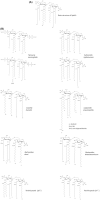Lipid A heterogeneity and its role in the host interactions with pathogenic and commensal bacteria
- PMID: 37223360
- PMCID: PMC10117875
- DOI: 10.1093/femsml/uqac011
Lipid A heterogeneity and its role in the host interactions with pathogenic and commensal bacteria
Abstract
Lipopolysaccharide (LPS) is for most but not all Gram-negative bacteria an essential component of the outer leaflet of the outer membrane. LPS contributes to the integrity of the outer membrane, which acts as an effective permeability barrier to antimicrobial agents and protects against complement-mediated lysis. In commensal and pathogenic bacteria LPS interacts with pattern recognition receptors (e.g LBP, CD14, TLRs) of the innate immune system and thereby plays an important role in determining the immune response of the host. LPS molecules consist of a membrane-anchoring lipid A moiety and the surface-exposed core oligosaccharide and O-antigen polysaccharide. While the basic lipid A structure is conserved among different bacterial species, there is still a huge variation in its details, such as the number, position and chain length of the fatty acids and the decoration of the glucosamine disaccharide with phosphate, phosphoethanolamine or amino sugars. New evidence has emerged over the last few decades on how this lipid A heterogeneity confers distinct benefits to some bacteria because it allows them to modulate host responses in response to changing host environmental factors. Here we give an overview of what is known about the functional consequences of this lipid A structural heterogeneity. In addition, we also summarize new approaches for lipid A extraction, purification and analysis which have enabled analysis of its heterogeneity.
Keywords: bacteria; barrier function; heterogeneity; immune response; lipid A; outer membrane.
© The Author(s) 2022. Published by Oxford University Press on behalf of FEMS.
Conflict of interest statement
The authors declare no conflicts of interest.
Figures

Similar articles
-
Lipopolysaccharide heterogeneity: innate host responses to bacterial modification of lipid a structure.J Dent Res. 2005 Jul;84(7):584-95. doi: 10.1177/154405910508400702. J Dent Res. 2005. PMID: 15972584 Review.
-
Outer Membrane Lipid Secretion and the Innate Immune Response to Gram-Negative Bacteria.Infect Immun. 2020 Jun 22;88(7):e00920-19. doi: 10.1128/IAI.00920-19. Print 2020 Jun 22. Infect Immun. 2020. PMID: 32253250 Free PMC article. Review.
-
The Oligosaccharide Region of LPS Governs Predation of E. coli by the Bacterivorous Protist, Acanthamoeba castellanii.Microbiol Spectr. 2023 Feb 14;11(1):e0293022. doi: 10.1128/spectrum.02930-22. Epub 2023 Jan 17. Microbiol Spectr. 2023. PMID: 36648221 Free PMC article.
-
Structural Modifications of Bacterial Lipopolysaccharide that Facilitate Gram-Negative Bacteria Evasion of Host Innate Immunity.Front Immunol. 2013 May 24;4:109. doi: 10.3389/fimmu.2013.00109. eCollection 2013. Front Immunol. 2013. PMID: 23745121 Free PMC article.
-
Remodelling of the Gram-negative bacterial Kdo2-lipid A and its functional implications.Microbiology (Reading). 2022 Apr;168(4). doi: 10.1099/mic.0.001159. Microbiology (Reading). 2022. PMID: 35394417 Review.
Cited by
-
A critical role for Vibrio parahaemolyticus LPS to mediate evasion of host immune response during infection.Proc Natl Acad Sci U S A. 2025 Aug 19;122(33):e2426547122. doi: 10.1073/pnas.2426547122. Epub 2025 Aug 13. Proc Natl Acad Sci U S A. 2025. PMID: 40802686 Free PMC article.
-
Diversity, Complexity, and Specificity of Bacterial Lipopolysaccharide (LPS) Structures Impacting Their Detection and Quantification.Int J Mol Sci. 2024 Mar 31;25(7):3927. doi: 10.3390/ijms25073927. Int J Mol Sci. 2024. PMID: 38612737 Free PMC article.
-
Discrimination of Klebsiella pneumoniae and Klebsiella quasipneumoniae by MALDI-TOF Mass Spectrometry Coupled With Machine Learning.Microbiologyopen. 2025 Aug;14(4):e70035. doi: 10.1002/mbo3.70035. Microbiologyopen. 2025. PMID: 40660849 Free PMC article.
-
Milestones in the development of Myxococcus xanthus as a model multicellular bacterium.J Bacteriol. 2025 Jul 24;207(7):e0007125. doi: 10.1128/jb.00071-25. Epub 2025 Jun 17. J Bacteriol. 2025. PMID: 40525847 Free PMC article. Review.
-
Defense mechanisms of Salmonella against antibiotics: a review.Front Antibiot. 2024 Sep 17;3:1448796. doi: 10.3389/frabi.2024.1448796. eCollection 2024. Front Antibiot. 2024. PMID: 39816264 Free PMC article. Review.
References
-
- Agodi A, Voulgari E, Barchitta Met al. Spread of a carbapenem- and colistin-resistant Acinetobacter baumannii ST2 clonal strain causing outbreaks in two Sicilian hospitals. J Hosp Infect. 2014;86:260–6. - PubMed
-
- Altinok I, Ozturk RC, Kahraman UCet al. Protection of rainbow trout against yersiniosis by lpxD mutant Yersinia ruckeri. Fish Shellfish Immunol. 2016;55:21–7. - PubMed
Publication types
LinkOut - more resources
Full Text Sources
Research Materials
Miscellaneous
